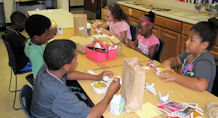Paper Cranes; Lasting Peace

After World War II, the origami crane became a symbol of peace in a number of Asian countries, and has since become a universal emblem. About five years ago, University of Michigan-Flint Assistant Professor of Social Work Elizabeth Collardey and her husband Tim used the paper peace crane as the central theme of a year-long peace education project to fold 1,000 peace cranes in Dubuque, Iowa.
That project became the foundation of community engagement and scholarship for Collardey, PhD, LMSW. She conducted an evaluation of the peace project that led to her and her husband developing a curriculum of peace studies that would be the focus of each peace class session. In April 2011, an adapted version of that peace class was started with 10 youngsters at the Boys & Girls Club of Greater Flint.

The peace class goes beyond just making 1,000 origami Peace Cranes, one of the results of the study of the Dubuque project (currently under review by the Peace Studies Journal) indicated that food security (accessibility and affordability of food) was an essential part of disadvantaged children's meanings and experiences of peace.

"Based on the findings from the pilot study, we expanded the peace class to include a community organic garden component," explained Collardey. "The garden is in the shape of a Native American medicine wheel, and in the north quadrant, we grew the three sisters: corn, beans, and squash to honor this land's first farmers."
Collardey is already involved in researching the results of her current peace education class. She wants to not only evaluate the effectiveness of a year-long peace education, but also examine the meanings and experiences of peace from a child's perspective, not as adults interpret children's lives.
"This is a phenomenological study and I am fortunate to have two undergraduate social work students, part of the Undergraduate Research Opportunity Program (UROP), as research assistants," said Collardey. "These students will be presenting their case studies at a national social work conference in March 2012."
Phenomenology asks the question of "what is the essence of a specific phenomenon? The research will seek to identify: "what is the essence of peace for children?"
The peace class students are very close to completing the goal of 1000 peace cranes that will be used to create a traveling display. It will open at the Flint Public Library Reading Room from November 29-December 12, from December 15 to January 3, it will be on display at the Courtland Center Mall, it moves to the downtown Lunch Studio on January 4, and in April at the Buckham Gallery.
Collardey has plans to expand the peace program to a second site in early 2012.
"Hopefully, our second site will open in January at the Pierce Creative Arts Academy, which will provide a different population to compare children's meanings of peace. The following year we hope to expand to a site serving adolescents which would give us a broad understanding of peace from a developmental perspective."
Related Posts
No related photos.
UM-Flint News
The Office of Marketing & Communications can be reached at mac-flint@umich.edu.